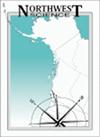Inviable Seed Set Affects Arthropod Damage to Seeds of Western Juniper (Juniperus occidentalis)
IF 0.5
4区 环境科学与生态学
Q4 ECOLOGY
引用次数: 0
Abstract
Abstract Retention and development of fruits containing inviable seeds has been considered anomalous, because such seeds cannot contribute to plant fitness. Although trees in the genus Juniperus are conifers and thus not true fruiting plants, junipers package seeds within fruit-like female cones commonly referred to as “berries,” and juniper seeds often exhibit high levels of inviability. We tested the prediction that inviable seeds in western juniper (J. occidentalis) reduce levels of pre-dispersal seed predation by arthropods. From 2009 to 2014 we assessed production of berries and seeds in two northeast California populations of western juniper and documented presence of four arthropods (three seed predators, one fruit predator) as well as condition of seeds. The number of inviable seeds per juniper berry was directly associated with numbers of the pulp-feeding frugivore in berries collected both in fall and spring, suggesting that trees may abort seeds within berries experiencing heavy frugivore damage. Consistent with the hypothesis that inviable seeds can reduce seed predation, numbers of a granivorous mite were inversely related to numbers of inviable seeds in fall berry collections. However, the pattern switched to a direct relationship between mites and inviable seeds in spring-collected berries, perhaps due to the timing of mite infestation during berry development. Inviable seeds occurred most frequently during a year of mast production of juniper berries, and the lowest levels of seed damage by a granivorous chalcid wasp occurred during the mast year. The following year saw the greatest levels of seed damage by granivorous moths and mites, possible hold-over effects from large populations built during the mast year. The production of inviable seeds, together with satiating granivores through masting, may represent complementary mechanisms for reducing pre-dispersal seed predation.西杉树种子不结实结实对节肢动物损伤的影响
摘要含有隐形种子的果实的保留和发育被认为是异常的,因为这种种子不能促进植物的适应性。尽管杜松属的树木是针叶树,因此不是真正的结果植物,但杜松将种子包裹在果实状的雌性球果中,通常被称为“浆果”,杜松种子通常表现出高水平的隐形性。我们测试了西刺柏(J.occidentalis)的隐形种子降低节肢动物在传播前对种子的捕食水平的预测。从2009年到2014年,我们评估了加利福尼亚州东北部两个西杜松种群的浆果和种子产量,并记录了四种节肢动物(三种种子捕食者,一种果实捕食者)的存在以及种子状况。每个杜松浆果的隐形种子数量与秋季和春季采集的浆果中以果肉为食的食腐动物的数量直接相关,这表明树木可能会在遭受严重食腐动物破坏的浆果中中止种子。与隐形种子可以减少种子捕食的假设一致,在秋季浆果采集中,食粒螨的数量与隐形种子的数量呈负相关。然而,这种模式转变为春季采集的浆果中螨虫和隐形种子之间的直接关系,可能是由于浆果发育过程中螨虫侵扰的时间。在杜松浆果肥大的一年中,最常见的是不可见的种子,而食颗粒的霰黄蜂对种子的破坏程度最低,发生在肥大的一年间。第二年,食颗粒蛾和螨虫对种子的破坏程度最高,可能是由于在肥大年份建立的大量种群造成的滞留影响。隐形种子的产生,以及通过繁殖使食粮动物饱腹,可能是减少传播前种子捕食的互补机制。
本文章由计算机程序翻译,如有差异,请以英文原文为准。
求助全文
约1分钟内获得全文
求助全文
来源期刊

Northwest Science
环境科学-生态学
CiteScore
1.30
自引率
0.00%
发文量
23
审稿时长
>36 weeks
期刊介绍:
The pages of Northwest Science are open to original and fundamental research in the basic, applied, and social sciences. All submissions are refereed by at least two qualified peer reviewers. Papers are welcome from authors outside of the Pacific Northwest if the topic is suitable to our regional audience.
 求助内容:
求助内容: 应助结果提醒方式:
应助结果提醒方式:


